Air Conditioning Outdoor Unit: Dimensions and Installation Tips

Today hardly any private house, apartment, as well as shopping centers and offices can do without an air conditioner. Split systems are in the greatest demand today. This is a type of air conditioner that includes outdoor (portable) and indoor units. Their coordinated work is the key to the proper functioning of the split system.
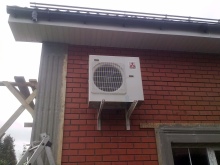
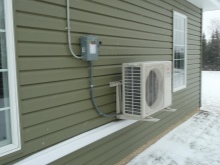

What does the external block consist of?
Since the outdoor unit is exposed to high and low temperatures, increased requirements for the quality of performance are imposed on it. Its shape, resembling a rectangular parallelepiped, allows you to place a set of the following parts and nodes inside the body.
- Fan - blows on the condenser that cools the freon.
- Condenser - freon cools down in it and passes from a gaseous state to a liquid state.
- Compressor - an engine that pumps an increased pressure of the refrigerant, forcing it to move along the circuit (coil) of the refrigerator.
- Four-way valve - air conditioners designed for heating and cooling modes are equipped with it. This detail, on command from the control panel of the indoor unit, changes the movement of freon and, accordingly, cooling in the summer to heating in the cold season.
- ECU - this module is installed on the outdoor units of inverter air conditioners. It is they who are less sensitive to temperature changes than devices with non-inverter control.
- Taps for connecting tracing pipes connecting the indoor unit to the outdoor unit. Freon flows through these pipes. Like wiring with a corrugation, they are protected by a box.
- Retaining grid - protects parts and assemblies of the outdoor unit from large objects, debris and insects.
- Cover that protects the electrical terminals from atmospheric precipitation.
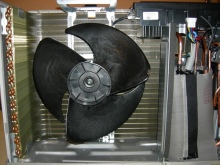
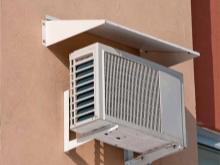
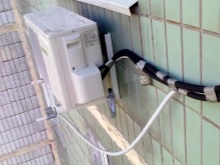
This is the minimum set of elements, without which the circuit is broken, the operation of the device is impossible. Also, the outdoor unit may have the following parts.
- Voltage stabilizer is a protective circuit of electronic and electromechanical elements and assemblies that are especially sensitive to voltage surges.
- Visor - protects the outdoor unit from precipitation, reduces icing of the case.
- Condensate water hose. Connect it to the sewer or use it for drip irrigation of plantings growing nearby. In winter, when heating and cooling are reversed, additional heating is used to prevent freezing - the condensate does not freeze with icicles on the body, but all drains off.

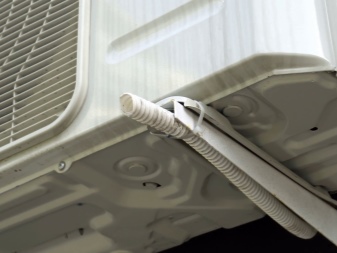
To prevent other troubles, put on the outdoor unit:
- thorns - so that the birds do not sit down;
- reinforcement cage (this is the vandal-proof grill) - to protect against theft, it is not necessary to install it on the balcony and above the 1st floor;
- mosquito net - to prevent poplar fluff and leaves from getting inside the block.
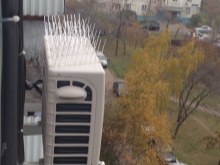


What is it needed for?
Window air conditioners are practically the yesterday of microclimate technology. They occupied one of the upper window openings, and the noise from the outdoor unit in the room was commonplace. The efficiency of window air conditioners was much lower, and energy consumption was much higher. So, the external block of a split air conditioner (literally - a split air conditioning system) is designed to eliminate these disadvantages, namely:
- remove the main source of noise and heat in summer (or cold in winter) outside the building, structure, house;
- significantly reduce energy consumption and increase efficiency;
- simplify maintenance - do not disassemble the entire air conditioner for cleaning, washing and repair at once, but divide the work into 2 fronts.
The disadvantage of a split system is that when installing and servicing at high altitudes, the customer (and the contractor) cannot do without the help of a truck crane or climbers.


Dimensions (edit)
Individuals - owners of apartments and summer cottages, for example, do not chase multi-kilowatt power. If you do not create "autumn cold" in the room from 17 degrees, then the temperature of 21-24 degrees in summer is considered relatively normal for most people. The calculation takes into account the power of the air conditioner up to 2.7 kW. Then the average height of the outdoor unit will be only half a meter. The width of the block is up to 0.7 m, the depth is up to 0.4, taking into account the removal of the device on suspensions when the distance from the wall is up to 10 cm. The dimensions of the external block of the air conditioner with a consumption of 3.5 kW can reach 55 × 76.5 × 28.5 cm, however, each manufacturer changes these indicators downward. The weight of the complete outdoor unit is 12-25 kg.

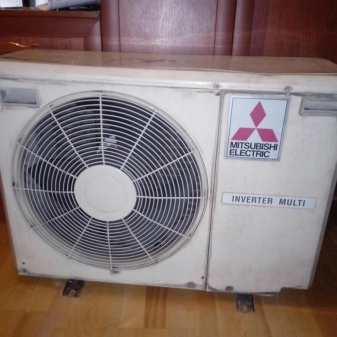
The smallest air conditioner is Ballu BSWI-09HN1. The model is not devoid of the main blocks and assemblies necessary for high-quality cooling of the air inside the house. It is suitable for a room up to 16 m2, consumes only 900 W when the compressor is running, maintains a temperature of 21-23 degrees in summer in the heat, even if it is 35 degrees outside the window. The dimensions of the external block are 70 * 28.5 * 18.8 cm. The unit is compact, weighs a little more than a vacuum cleaner. You will hardly find a split system smaller and easier. It makes no sense to produce external blocks of a split system smaller than a postal parcel. Microconditioning of air is already the lot of self-made experimentalists, although the technologies have been worked out.
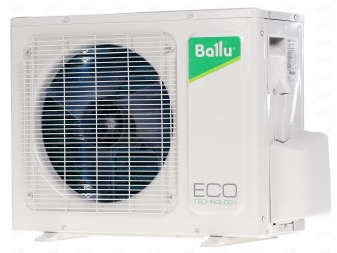
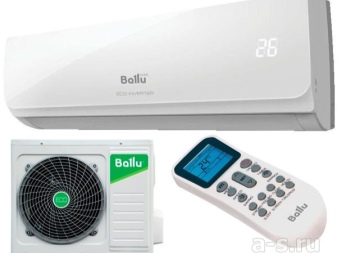
Where to install?
If you live (or work) on the ground floor, then the installation height from the ground is at least 2 m. This will help to avoid damage or theft of the unit. Be sure to install the outdoor unit in a welded reinforcement cage with thick (from 1.5 cm) rods. The cage itself must be locked with a massive anti-burglar lock. Its door must have reinforced hinges. It is not necessary to lock the block “behind bars” on the second and subsequent floors.
On the top floor in order not to call climbers or a truck crane (both of them take hourly wages for work), some firms put external blocks on the edge of the roof... The maximum length of the refrigerant pipe (for each pipe) is 20 m. A large difference in height between the outdoor and indoor units significantly wears out the compressor. He spends additional energy to overcome the force of gravity acting on the height of the liquefied freon column.
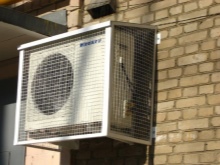
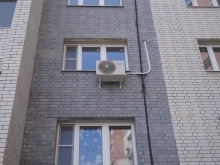

As a result, the cold received in summer (or warm in winter) will be insufficient, not corresponding to the value declared by the manufacturer. Or the air conditioner will immediately issue an alarm after starting. The best solution is to locate the outdoor and indoor units at the same height. In a private house, the outer block is often placed on the facade of the building. This applies to all types of air conditioners, including the wall-mounted indoor unit.

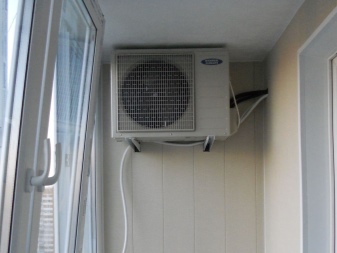
Installation rules
Without observing the following rules, the operation of the installed air conditioner can be significantly complicated or even impossible.
- Brackets and brackets are installed with a margin of safety up to several times than the strength required to suspend the outdoor unit. Ideally, both bindings together should be able to support the weight of a person.
- The load-bearing wall must be strong and smooth enough. Uneven walls with old plaster and loose blocks and bricks from which the masonry was made are excluded. Otherwise, the hanging device may fall and injure someone from the passers-by.
- On facades with a porous finish, for example, composite soffits on foam plastic, fasteners are not mounted on the finish itself, but are drilled and cut into the wall (plaster, bricks). This will give the suspended structure the necessary strength and stability.You can use the basket - a ready-made lattice structure, into which the external unit is lowered before connecting to the internal and mains voltage source.
- Do not put the outdoor unit of the air conditioner close to the wall - this will not give it natural ventilation from the wind. The distance between the back wall of the outdoor unit and the wall finish is at least 0.1 m.
- The technician or owner of the air conditioner performing maintenance must have easy access to the outdoor unit. Mount the device so that it becomes possible to quickly clean it, quickly replace worn parts and assemblies.
- Do not hang the outdoor unit vertically or tilted to either side. Its horizontality is set strictly according to the level - this is necessary for uninterrupted circulation of freon in both directions.
- The place of installation can serve as a balcony or loggia, not covered with double-glazed windows. The glazed space will create a locked chamber, where soon the temperature will reach 55 degrees, and the operation of the air conditioner will be interrupted - the heat must go somewhere.
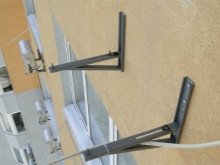
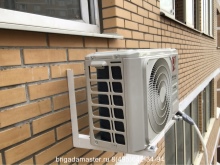
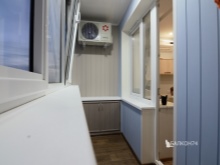
The placement of communications is also not contrary to the following rules.
- The maximum distance between the external and internal blocks can reach 30 m. However, there is a risk of completely losing all the useful effect: while the cooled freon passes these 30 m, it will heat up almost to the initial temperature. The compressor will run continuously, which can lead to rapid wear. Modern split systems with protection based on a self-diagnostic module, after useless work for several minutes, having found that the temperature in the room has not dropped by a degree, simply turn off the power to the compressor and fans of the indoor and outdoor units. The optimum distance is 5 m for each of both pipes, then the losses are small.
- Copper pipes must be sealed and thermally insulated.
- In the absence of a final finish, it is advisable to hide the track in the wall. Otherwise, place it in a box. But access to pipe and electrical connections must be present.
- It is not allowed to sharply bend the pipes - this will complicate the passage of freon.
- It is advisable to lay a separate line for the air conditioner with a fuse switch.
- Route the hose to drain the condensed water into the drain. It is recommended to run the drain line separately in the walls.
- It is recommended not just to put engineering communications into the wall, but to pass them through a special cup holder - from the outside.
- Hide the freon pipes, the electric cable and the drain hose in the foam rubber tubes. Then protect them with vinyl tape.
- Before pumping in freon using a vacuum pump, evacuation is carried out. It will remove the remaining air and prevent freon from turning into waste gases, the benefit of which is less. In addition, the tubes are protected against corrosion by vacuum.
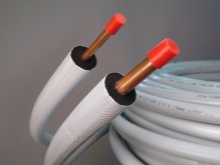
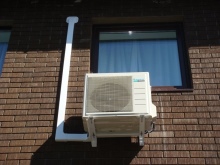

The delivery of the installed air conditioner is preceded by a test run and a check of the device for freon leaks. Equally important indicators are the constant freon pressure and the regularity of condensate removal.
Operating tips
These rules are easy to apply - they are dictated by common sense and are easy to remember.
- It is forbidden to push foreign objects through the bars of the cage of the external unit, as well as through the curtains of the internal one. Keep children away from the operating device.
- Check that the room temperature maintenance is turned on at 21-26 degrees. A lower temperature during the heat can bring a healthy person to a cold - going outside after many hours of being in the cold represents temperature fluctuations of 10 degrees or more, as during a sharp change in the weather in the off-season.
- Do not allow the air conditioner to operate with the windows open. Modern technology prevents the compressor from overheating and the useless operation of the fans, if the temperature in the room after switching on has not dropped even by a few tenths of a degree.But not all models are equipped with such a "smart" function - in low-budget models of air conditioners it is simply not there. The device will work absolutely ineffectually, like an old Soviet refrigerator, in which the compressor does not turn off around the clock. As a result, all motors of the air conditioner will fail before the warranty period expires.
- Cover the window on a bright sunny day - excess daylight does not allow the indoor unit to adequately perceive the signal from the infrared LED of the remote control. This or that command is triggered every other time - you need to bring the remote control too close to the air conditioner for it to pass.
- Do not use the air conditioner, for example, in the bathroom - excess vapor in the indoor unit turns into excess condensation, which clogs the drain and filters.
- Run the air conditioner regularly in a clean fan mode - this will blow out excess condensation.
- Clean the indoor unit filters every 2 weeks. It is advisable to wash the outdoor unit at least once every 1-2 months.
- Do not place heaters or heaters near the indoor unit. The minimum distance is 1 m.
- Provide adequate protection for the air conditioner from sources of interference. The indoor unit should not be in close proximity to devices that use radio signals for data transmission and cellular communication. So, do not install 3G / 4G modems, routers or Wi-Fi repeaters, a home PC system unit, etc. As for the external unit, it is forbidden to place it, for example, near a cell tower and radio relay equipment, if they are near on the roof - the power of their signal is ten times greater than the emitted power of a smartphone or tablet. Interference from them can reach the processor of the indoor unit and interfere with its operation - especially when the clock frequency of the processor coincides with the side frequencies that are abundant near any antenna.
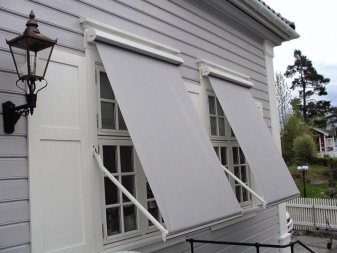
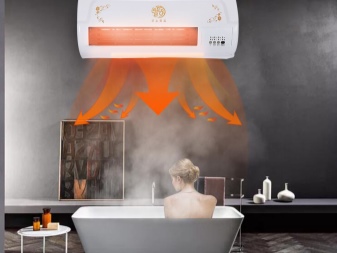
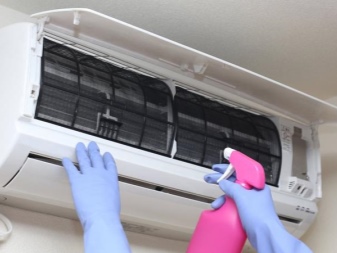
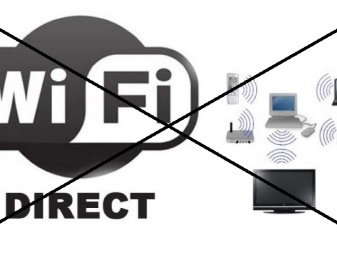
For information on what errors may be when installing the outdoor unit of the air conditioner, see the following video.













The comment was sent successfully.